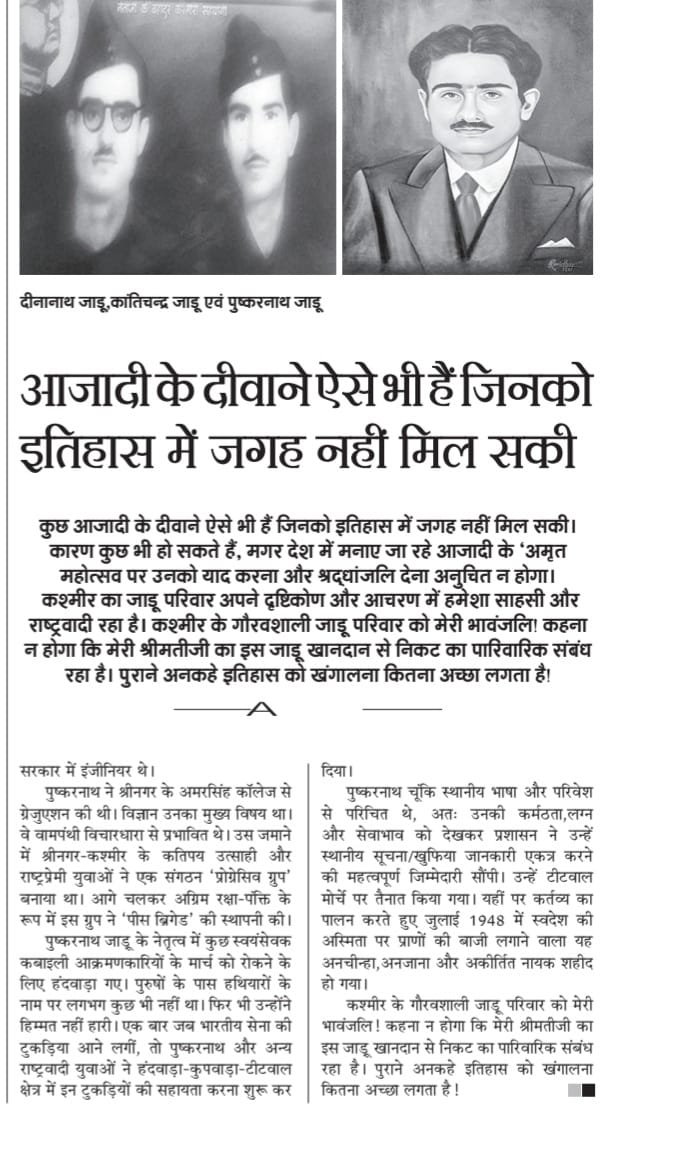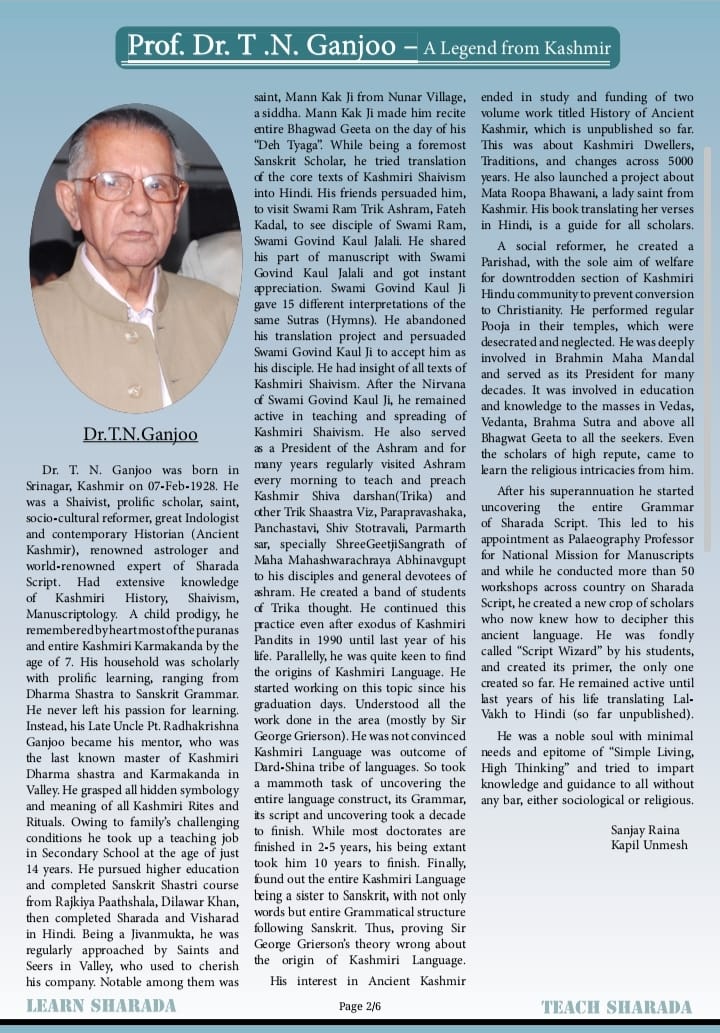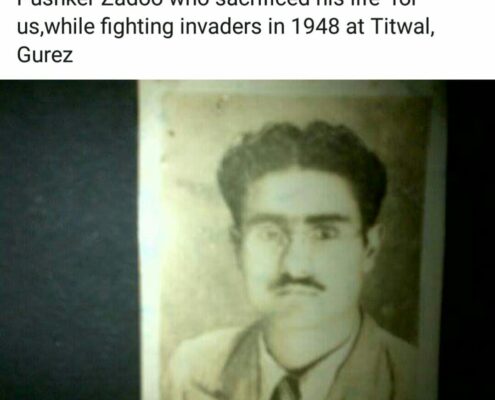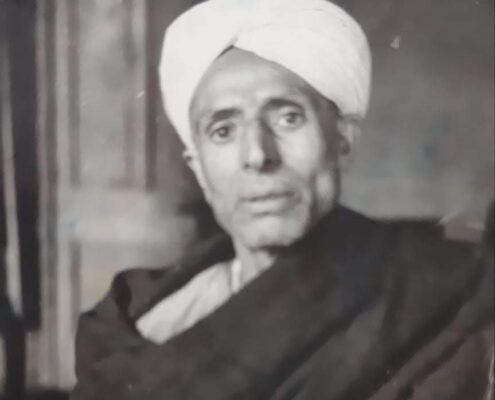Our Great Legandaries



Earliest Community Martyr
Late Sh Pushkar Nath Zadoo
From The Extraordinary Zadoo Family
The earliest community martyrs are Pushker Zadoo and Som Nath Bira. Both lost their lives fighting the Pakistani raiders in the 1947 Kashmir War. Pushker Zadoo sacrificed his life fighting the invaders on the Titwal Front in July 1948 at the young age of 18. Som Nath Bira laid down his life some where near Doda. He was a young man aged 23. Pushker Zadoo belonged to the illustrious Zadoo family that has produced a galaxy of scholars, scientist- engineers and educationists. The patriarch Pandit Keshav Bhat Zadoo was the legendary Sanskrit scholar and Court Pandit during Maharaja Ranbir Singh’s time and the proud owner of the unique birchbark Sarafa manuscript of the Paipallada Shakha of the Atherva Veda. It was the only copy of its version in the whole world and later acquired by the German Indologist Rudolph Von Roth in 1875. . Incidentally Jaggadhar was son in law of the legendary Mahamohupadhyaya Mukund Ram Shastri. Another son of the Zadoo family Vasu Dev Zadoo was the first ever KP to go to America in 1927. There he studied Sanitation Engineering at the famous Harvard University. He returned to India in 1933 after stints of studentship in England , France and Germany. Back in India he rose to the position of Chief Engineer in Jammu & Kashmir. Vasu Dev also served as Chairman of AMIE, J&K Chapter. Pushker Zadoo was son ofVasu Dev Zadoo. Not only did the Zadoos produced eminent scholars, educationists and engineer scientist but the family gave two more of its sons to serve the country. These were Jaggadhar Zadoo’s two sons Kanti Chander Zadoo and Dina Nath Zadoo. Both served the INA under the inspiring leadership of Subhash Chander Bose. Kanti Chander served as Personal Secretary to Neta ji Bose and reportedly died in the same plane crash in 1945 that consumed the lives of both during a flight from Malaysia to Japan. The elder brother Dina Nath Zadoo served as a Major in the combat wing of the INA and fought against the Allies in Malaysia. Kanti Chander and Dina Nath were sons of Jaggadhar Zadoo. Thus this illustrios Zadoo family gave three of its sons in the service of the nation while two of them attained martyrdom fighting for the nation and its struggle for independence. Jaggadhar Zadoo lived at Nai Sarak while his younger brother Vasu Dev resided at Exchange Road in Srinagar. Perhaps it may not be out of place to state that this Zadoo family has the unique distinction of producing pioneers of KP history in several fields across, literature, education, scholarship, martyrdom for the country, contribution to science like no other in Kashmir’s modern history. It is therefore all the more incumbent on the community to explore and find more details of the extraordinary achievements of this outstanding family- Zadoos

Sh Ragu Nath Ji Razdan
Old times were fully spiritual manifested era supported by great pious , honest , simple luminaries and Gurus who at times selflessly contributed to the best of their efforts and efficient capabilities as the Jhotshichrarya . This would not only guide masses in performing their religious rites but also awaken and bind them for sincere building nation . One among them was Revered Sh Ragu Nath Ji Razdan of Ganpathyar in Srinagar , J&K. He was one of the renowned Jothshicharyas of mid twentieth century who had obtained then degree in Astrology and was adept in Karam Kand. It was the time when all horoscopes etc were in Sharda Lipi . In addition being a great scholar of Sharda and Sanaskrit, he has also an expertise in calligraphy with beautiful hand writing . At the early age of twenties Shri Ragu Nath Ji Razdan was engaged in transliteration of valuable treasure of very old sharda manuscripts by then the courtiers of Maharaj Pratap Singh for his extra ordinary contribution to reveal the hidden treasures gifted by our many old ancestors. Mahraj Pratap Singh personally rewarded him for his excellence over the subject and valuable contributions. In addition due to his sincerity, dedication and authority over the subjects, Ali Mohd and sons of Haba Kadal and Kapoor Brothers would always engage him in setting the question papers of different schools of Srinagar city . His astro calculations were so strong that even one of community luminaries Pt Prem Nath Shastri would engage him to write Holy Almanacs for him and so for Brahman Maha Mandal. His hard work, authority over the subject and reputation as a guide to community would make him to spend months together at Bijbehara and Vecharnag with other renowned Jothshicharyas for discussions and would give final shape to Holy Almanac. His great contribution to the community and Brahman Maha Mandal in particular is of great importance and sincere reward to the humanity . He is remembered as one of the great luminaries and pious personality .Om Shanti.
Profile of Pandit Keshav Bhatt Jyotishi
[ A profound scholar of astrology and a pioneer printer in one – that was Pandit Keshav Bhatt Jyotishi. His greatest claim to fame, however rests on his untiring efforts in publishing cheap editions of ancient religions texts of Kashmiri Hindus and making them available to the common people. For this he would go from place to place in Kashmir, almost door to door, and collect original manuscripts from people who were most loathe to part with them. Perhaps he was the only scholar after Buhler to have done that with a good measure of success. But for him many of these texts would have been lost or remained obscure especially those on Kashmiri Hindu rituals and religious practices. The Krishna Printing Press, which he set up in Srinagar, came handy to him for printing the texts and also to eke out a modest living for himself. We at ‘Unmesh’ feel proud in paying a tribute to the great scholar’s memory and in telling our readers about his life and accomplishments.]
For the older generation of Kashmiri Pandits, Pandit Keshav Bhatt Jyotishi (KBJ) has been a familiar name, for the Panchang (almanac) he edited and published would reach almost every Pandit household in Kashmir. It evoked, and still evokes, reverence in the hearts of those who are aware of his deep knowledge of Hindu astrology. For them his word in the field bore a stamp of undisputed authenticity. KBJ in turn owed it to his ancestral tradition with proclivity towards astrology running very strongly in the family.
Born in Srinagar in 1873 in an erudite Brahmin family, KBJ, only emulated his grandfather Pandit Sat Ram, his father Pandit Prasad Bhatt and uncle Pandit Mukund Ram when he chose Sanskrit religious texts and astrology as his specialized field of study. Both the father and the uncle acquired proficiency in these subjects under the tutelage of his grandfather, a well known scholar of his times. Uncle Mukund Ram, a Shaivite scholar, rose to be the Chief Astrologer at the court of Maharaja Pratap Singh, while father Prasad Bhatt also earned a name for his study of astrology. Surpassing both of them, KBJ acquired a mastery over the subject almost to the extent of becoming a legend in his lifetime.
The Bhatts’ ancestral house at Jogi Lankar, Rainawari, a locality of Srinagar, overlooked a beautiful scene on the flowing canal, evoking an atmosphere of serenity. It was in this house that young KBJ would remain absorbed in study, sitting on the grass mat near the window on the left with piles of books neatly rising above the floor all around him. Devoting himself entirely to learning the Shastras, he virtually shut himself from worldly pleasures which had little attraction for him. While following his scholarly pursuits, KBJ began his career as a school teacher at Nunar, a picturesque village not far off from Tulmula (KheerBhawani). Dedicated to his work and committed to giving quality education to his students, he would traverse all the distance from his home at Rainawari to the school at Nunar on foot – he simply could not afford the bus or tonga fare to his place of work. Fond of him and full of respect for him, his students would often come to his home also where he would clear their doubts and help them in solving their difficulties. An inspiring pep talk on moral values to help them in their overall development was an usual.
